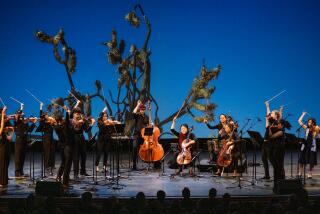Touring Southeast Asian Music With Instrumental Guide : Album reviews: Several recordings of classical and traditional styles reveal much about the region’s performers and diversity.
- Share via
To the West, Southeast Asia has always been a musical mystery zone.
Take away the stately gamelan orchestras of Indonesia, and hardly any of the classical or popular music styles from the region have received much exposure in the Western world. Suddenly, a bumper crop of fresh recordings documenting the classical and traditional music of countries in Southeast Asia is being released.
Nearly all boast a generous 70 minutes of music per disc as well as liner notes crammed with musical and historical details about performers and regional styles that are largely unknown in the West. Most of the music is linked to religious observances.
Albums are rated on a scale of * (poor) to **** (excellent), with *** denoting a solid recommendation.
*** 1/2, Various Artists, “The Music of Vietnam”, Celestial Harmonies
Indigenous music from Vietnam is atypical among Southeast Asian countries in that there’s little relation to gamelan. According to the liner notes to this three-CD set, the music of China left the deepest mark on Vietnamese styles, which emphasize stringed instruments such as lutes and dulcimers and which make the music surprisingly accessible.
Produced by New Zealand musician David Parsons with his wife, Kay, for this Tucson label, this set has two CDs featuring a shifting ensemble of 15 classical musicians recorded in Hanoi. Several unusual instruments are employed, including the dan bau , a one-string guitar with a bamboo stem that bends notes like a “whammy bar,” and the k’ni , a rifle-shaped fiddle with a mouth attachment that can create a voice-box effect similar to that used by rock guitarists Peter Frampton and Joe Walsh in the ‘70s.
The music is so expertly performed and so beautifully sequenced--the focus shifting from ensemble to solo pieces, from stringed instruments to flutes--that attention never wanders.
On several pieces, when the full ensemble kicks in over a clippety-clop rhythm, it’s hard not to visualize the music as themes from imaginary Vietnamese Westerns.
The other volume, “Imperial Court Music Recorded in Hue,” is more rigidly structured, formal and closer to what many would expect Vietnamese traditional music to sound like. The most exciting pieces feature a clarinet playing long lines over pounding percussion, a combination common to the music of many Southeast Asian nations.
*
***, Various Artists, “The Music of Cambodia”, Celestial Harmonies
Something more vital than just recording music was at stake on this three-CD set--preserving the heritage of the Khmer music tradition that suffered the ravages of the Pol Pot regime. Two CDs were recorded in the Cambodian capital of Phnom Penh, one featuring ensembles playing the royal court music of the ancient Khmer Empire with the sequencing again enhancing the variety. The other contains solo instrumental performances that are less absorbing.
The first CD goes to the core of Cambodian culture by featuring music from the region around the temple of Angkor Wat, and mostly recorded inside the temple itself. The pinpeat orchestra combines oboe-like srlay , fiddle and assorted xylophones playing long melody lines over a gong-and-drum rhythm bed. The fullness of the pinpeat sound is offset by the open spaces in three selections by the Taam Ming ensemble consisting of srlay , the rare nine-gong gamelan and drums.
*
***, Various Artists, “Music of Indonesia 4: Music of Nias & North Sumatra”, Smithsonian/Folkways SF 40420
***, Various Artists, “Music of Indonesia 5: Betawi and Sundanese Music of Java”
Smithsonian/Folkways SF 40421
Smithsonian/Folkways was ahead of the curve on the Southeast Asian front with its six-volume “The Music of Indonesia” series of regional styles recorded in Indonesia in the early ‘90s. These two volumes are the most consistent in the series.
“Music of Nias” features the music of three ethnic ensembles, whose music ranges from the oboe-like sarune playing nonstop lines over hypnotic gong-and-drum percussion to an a cappella vocal ensemble. The “Betawi” CD offers a potpourri of three styles--the topeng betawi theater form driven by surging gongs, the tanjidor brass band sound and a less formal take on gamelan called ajeng from the area surrounding Jakarta.
*** 1/2, Various Artists, “Music for the Gods”, Rykodisc
These 1941 field recordings of Indonesian gamelan were edited and produced by Grateful Dead drummer Mickey Hart and Alan Jabbour and come with a story that would do a Hollywood screenwriter proud.
Brothers Sheridan and Bruce Fahnestock were veterans of one recording expedition in the area when, at the personal request of Franklin D. Roosevelt, they returned to Indonesia in 1941 to undertake military intelligence work. Their cover: recording the local music heard on “Music for the Gods” with a pair of disc-cutters on a ship connected to land by two miles of insulated cable.
The start of World War II prevented any commercial release of the recordings, and Bruce Fahnestock died off the coast of Indonesia in 1942. Sheridan became a newspaper publisher and died in 1965.
The acetate recordings and manuscripts of the expedition languished in an attic until Sheridan’s widow donated them to the Library of Congress in 1986.
*
“Music for the Gods” is a good introduction to gamelan for casual listeners because each acetate disc could only record five minutes of music. The sound is rough in spots, but the absence of melodic instruments makes it easy to hear the interplay between the tuned gongs that underlie the shimmering gamelan sound. A piece played on jew’s-harp by a 9-year-old girl and a vocal ensemble backed by saronen (oboe again), drums and gongs provide variety.
More to Read
The biggest entertainment stories
Get our big stories about Hollywood, film, television, music, arts, culture and more right in your inbox as soon as they publish.
You may occasionally receive promotional content from the Los Angeles Times.










